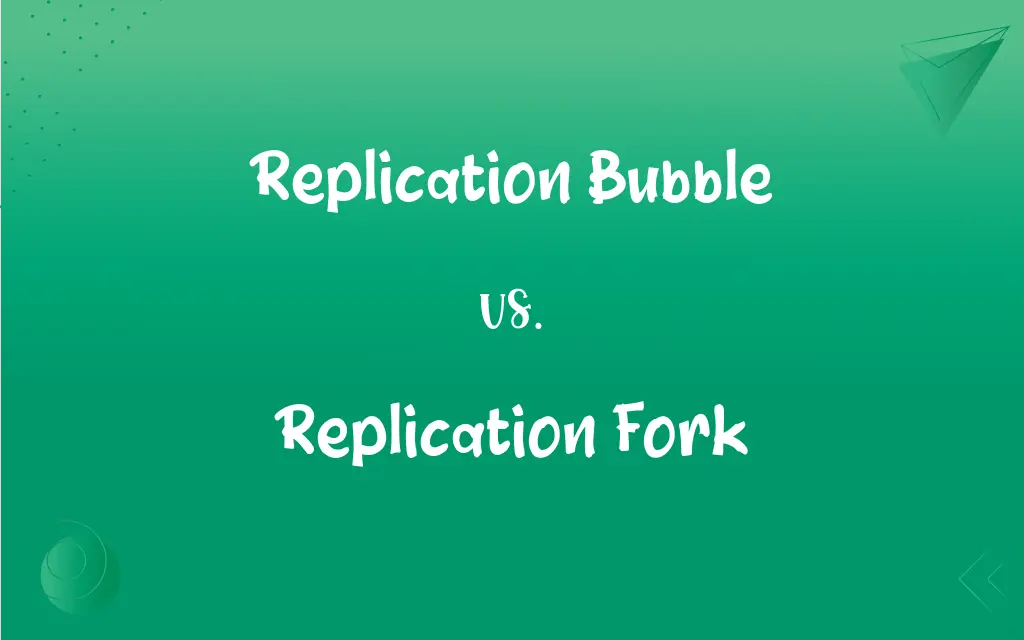Replication Bubble vs. Replication Fork: What's the Difference?
Edited by Aimie Carlson || By Janet White || Published on January 24, 2024
A replication bubble is a section of DNA where helicase unwinds the double helix, while a replication fork is the Y-shaped structure at each end of the bubble where new DNA strands are synthesized.

Key Differences
A replication bubble forms in DNA during the replication process, signifying the area where the double helix is unwound. This bubble indicates the active region where DNA replication is occurring. In contrast, the replication fork is a part of the replication bubble, specifically the Y-shaped structure at the edges of the bubble. Here, enzymes like DNA polymerase attach to synthesize new DNA strands.
The replication bubble is essential in eukaryotic DNA replication due to the length and complexity of chromosomes. Multiple bubbles can form along a chromosome, allowing replication to occur simultaneously at several points. On the other hand, each replication fork within these bubbles is where the actual synthesis of new DNA strands happens, with one fork moving in each direction.
In the replication bubble, the unwinding of the DNA helix is initiated by enzymes such as helicase. This unwinding is crucial for exposing the DNA bases so that they can be copied. Meanwhile, at the replication fork, other proteins stabilize the unwound DNA, and the DNA polymerase enzymes work to add complementary nucleotides to each strand.
As the replication bubble expands, more of the DNA double helix is opened up for replication. The bubble's growth is directly related to the activity of the replication forks moving away from the bubble's origin. The forks continue to progress until they meet forks from adjacent bubbles, at which point the replication is considered complete.
The size and number of replication bubbles can vary depending on the organism and the specific chromosome. They are an efficient way to replicate large DNA molecules quickly. In contrast, the replication fork is a more localized structure, and its movement and function are tightly regulated to ensure accurate DNA replication.
ADVERTISEMENT
Comparison Chart
Definition
A section of DNA where the double helix is unwound.
Y-shaped structure at each end of the replication bubble.
Role in DNA Replication
Indicates the active region of DNA replication.
Site where new DNA strands are synthesized.
Enzymes Involved
Helicase initiates the unwinding of the helix.
DNA polymerase synthesizes new strands.
Location in DNA
Can occur at multiple points along the chromosome.
Located at the edges of the replication bubble.
Relationship to DNA Replication
Crucial for exposing DNA bases for copying.
Directly involved in the addition of nucleotides.
ADVERTISEMENT
Replication Bubble and Replication Fork Definitions
Replication Bubble
In eukaryotic cells, replication bubbles facilitate the replication of long DNA molecules.
Replication bubbles ensure efficient DNA copying in human cells.
Replication Fork
Replication forks progress bidirectionally from the origin of replication.
The replication forks moved outward from the replication bubble's center.
Replication Bubble
Replication bubbles merge when adjacent replication forks meet, completing DNA synthesis.
As the cell prepared to divide, its replication bubbles gradually merged.
Replication Fork
The replication fork is where DNA polymerase attaches to replicate the DNA strands.
DNA polymerase worked diligently at the replication fork.
Replication Bubble
These bubbles form as enzymes like helicase break hydrogen bonds between DNA strands.
The replication bubble expanded as helicase unwound the DNA.
Replication Fork
A replication fork is the Y-shaped structure where new DNA strands are synthesized.
The replication fork moved along the DNA, adding nucleotides.
Replication Bubble
Replication bubbles are indicative of active DNA synthesis sites in a chromosome.
Scientists observed the replication bubbles to study the replication process.
Replication Fork
Replication forks are formed at each end of a replication bubble.
Two replication forks were active at each replication bubble in the DNA.
Replication Bubble
A replication bubble is a region in DNA where the double helix unwinds during replication.
During cell division, multiple replication bubbles formed along the chromosome.
Replication Fork
The stability and movement of the replication fork are critical for accurate DNA duplication.
To prevent errors, the replication fork's progression was carefully regulated.
FAQs
Where does a replication bubble form?
It forms at specific starting points called origins of replication.
What is a replication bubble?
It's a region in DNA where the two strands separate during replication, creating a 'bubble'-like structure.
Is there only one replication bubble per DNA molecule?
In eukaryotes, multiple bubbles can form, while in prokaryotes, it's usually just one.
Does the replication bubble move?
Yes, it moves along the DNA as replication progresses.
What happens to the replication bubble at the end of replication?
The bubbles merge, and the DNA re-zips into a double helix.
What is the role of the replication bubble?
It allows the replication machinery access to single-stranded DNA for copying.
How does the replication bubble expand?
It expands as the DNA helicase unwinds the DNA strands.
What is a replication fork?
It's the Y-shaped structure formed at the point where the DNA is split into two strands during replication.
Why is it called a replication bubble?
The structure resembles a bubble because of the way the DNA strands unwind and separate.
What enzymes work at the replication fork?
Enzymes like DNA polymerase, helicase, and ligase are crucial here.
Can replication bubbles overlap?
In eukaryotic cells, they can overlap as multiple bubbles form along the DNA.
What enzymes are involved in the replication bubble?
Key enzymes include DNA helicase, DNA polymerase, and primase.
How is a replication fork related to a replication bubble?
Each replication bubble has two replication forks, one at each end.
Is the replication fork symmetrical?
No, it has a leading and a lagging strand, requiring different replication processes.
What challenges are faced at the replication fork?
Issues like DNA damage or tight winding can pose challenges during replication.
What happens at the replication fork?
DNA polymerases synthesize new DNA strands by adding nucleotides to the original strands.
Why are there two forks in a replication bubble?
They allow DNA replication to proceed in both directions from the origin.
Does the replication fork move?
Yes, it moves along the DNA strand as replication progresses.
What is the rate of movement of a replication fork?
It varies between organisms but can be quite rapid, especially in prokaryotes.
How is the replication fork resolved?
Once replication is complete, the replication machinery disassembles, and the DNA re-forms into its usual double-helical structure.
About Author
Written by
Janet WhiteJanet White has been an esteemed writer and blogger for Difference Wiki. Holding a Master's degree in Science and Medical Journalism from the prestigious Boston University, she has consistently demonstrated her expertise and passion for her field. When she's not immersed in her work, Janet relishes her time exercising, delving into a good book, and cherishing moments with friends and family.
Edited by
Aimie CarlsonAimie Carlson, holding a master's degree in English literature, is a fervent English language enthusiast. She lends her writing talents to Difference Wiki, a prominent website that specializes in comparisons, offering readers insightful analyses that both captivate and inform.































































